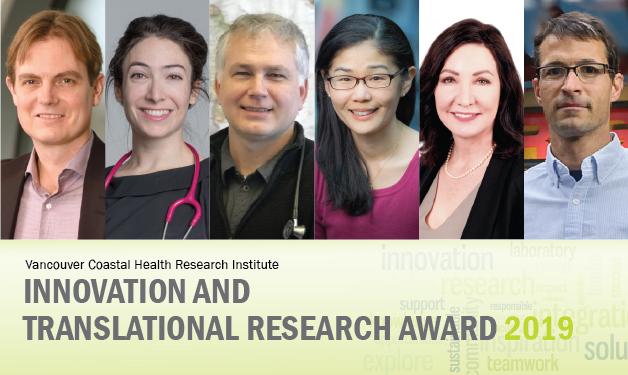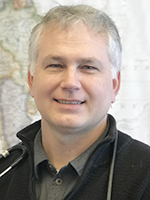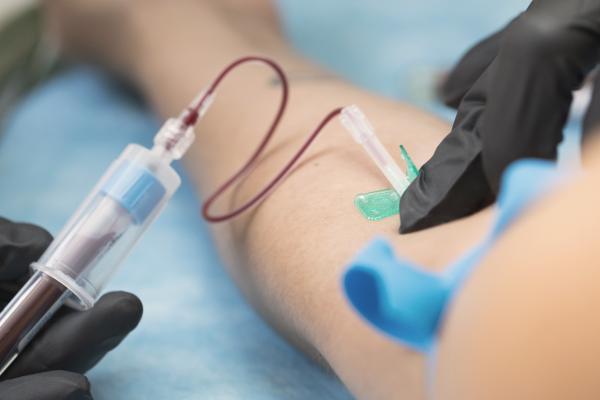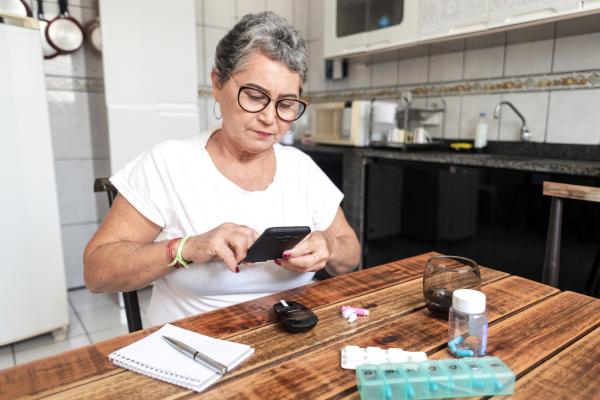
Congratulations to the 2019 Innovation and Translational Research Award recipients!
Meeting the health care needs of dynamic patient populations requires forward-thinking innovators. From curing disease to improving quality of life, researchers are at the forefront of medical advances that support the health and happiness of patients and their families. Vancouver Coastal Health Research Institute (VCHRI) is proud to contribute to visionary research with our annual Innovation and Translational Research Awards. This year’s five recipients are putting new knowledge into practice, implementing research outcomes and turning discoveries into commercial opportunities.
The 2019 Innovation and Translational Research Award winners are:
- Dr. Mads Daugaard, senior research scientist and head, Molecular Pathology and Imaging Facility, Vancouver Prostate Centre, VCH
- Dr. Thalia Field, stroke neurologist, VGH
- Dr. Richard Lester, physician-researcher and associate professor, Global Health, Division of Infectious Diseases, UBC
- Dr. Teresa Liu-Ambrose, physiotherapist, professor and Canada Research Chair in Physical Activity, Mobility and Cognitive Health; research director, Falls Prevention Clinic, VGH
- Dr. Cheryl Wellington, professor, Department of Pathology and Laboratory Medicine, UBC
- Dr. Andrew Kestler, emergency department physician at St. Paul’s Hospital
Designing a treatment for an aggressive childhood cancer

Study: A small molecule inhibitor of EWS-FLI1 for treatment of Ewing's sarcoma
Funded by: VGH & UBC Hospital Foundation
Ewing’s sarcoma (ES) is a bone and soft tissue tumour that mostly affects children and young adults. It can spread quickly and, despite aggressive treatment, the five-year survival rate for patients with metastatic diseases like this is only five to six per cent. ES is associated with chromosomal anomalies that affect a patient’s genes. The Vancouver Prostate Centre has previously utilized a computer-aided drug design (CADD) platform to target and stop the development of processes in the body that lead to the development of diseases like ES.
“This research is designed to determine the optimal safe and efficacious dose of a treatment for ES,” says Dr. Mads Daugaard. “Our objective is to use CADD to create a medication that will stop the processes that drive ES. To achieve this, we will validate the binding and targeting abilities of the identified lead compound and determine its metabolic stability.”
Machine learning prediction tool for Alzheimer’s and other neurodegenerative diseases

Study: Clinical data And NAtuRal language processing for earlY detection of dementia (CANARY)
Funded by: VGH & UBC Hospital Foundation
Alzheimer’s disease (AD) is a common, devastating and costly condition with no cure. To date, drug trials have failed in part due to the difficulty in identifying individuals with early stage disease, when disease-modifying drugs would be most likely to be effective.
“Our objectives are to refine and validate a multimodal machine learning algorithm to distinguish healthy individuals from those with mild cognitive impairment (MCI) and mild to moderate AD,” says Dr. Thalia Field.
The study will gather longitudinal data to discern risk markers for those individuals with subjective memory complaints/ MCI likeliest to develop AD.
“Our ultimate aim is for our algorithm to help in risk-stratifying individuals with regards to their risk of pre-clinical disease as a means to enrich future clinical trials examining treatments for neurodegenerative diseases.”
Virtual care for reduced hospital readmissions and improved health

Study: Reducing preventable hospital readmission using post-discharge virtual care: WelTel H2home
Funded by: VGH & UBC Hospital Foundation
Virtual care can improve the quality and efficiency of health care through supporting patients in their transition back to the community and preventing unplanned readmission to hospital. The WelTel (WT) holistic virtual care platform has been demonstrated to improve medication adherence and health outcomes using weekly text message check-ins. In this study, researchers will examine if the use of WT can avert unplanned hospital admissions and identify potential improvements to quality of care for patients and care providers.
The WT platform includes an easy-to-use dashboard, appointment reminders, links to other clinics and services, a password-protected patient portal for health information and the ability to host real-time virtual voice or video encounters.
“Open two-way communication lets patients connect to care in ways that are most meaningful to them,” notes Dr. Richard Lester. “Patient satisfaction using the platform has been very high to date, and frontline and allied health providers have reported improved efficiencies in team-based care.”
Preventing recurrent falls among older adults

Study: Enhancing the body-brain connection to improve physical, cognitive and mood outcomes in high-risk community-dwelling older adults
Funded by: VGH & UBC Hospital Foundation
Falls are a major cause of injury, disability, functional decline, institutionalization and death among older adults. Recurrent fallers—i.e., over two falls in 12 months—are at higher risk.
“Our prior work showed that exercise can significantly reduce falls in older adults who are recurrent fallers,” says Dr. Teresa Liu-Ambrose. “We now aim to conduct preliminary work on how to reduce the risk of injurious falls in this population. Preventing injurious falls is a critical outcome because they can result in brain injury and hip fractures.”
This research will compare whether community-dwelling older adults who fall recurrently would benefit from a home-based program of balance and strength training exercises, i.e., Otago Exercise Program (OEP), combined with mindfulness-based mediation (MBM) versus exercise alone. MBM may work synergistically with exercise to reduce the risk of injurious falls by improving attention and mood. Both exercise and MBM are low cost strategies.
“There is a lack of effective and scalable strategies that empower older fallers to reduce their risk for adverse outcomes,” says Liu-Ambrose. “Our proposed study addresses this void and aims to translate science into action at the healthcare delivery and community levels.”
Evaluating blood draw protocols for better concussion monitoring

Study: TAPping into concussion blood biomarkers: feasibility assessment of Touch Activated Phlebotomy (TAP) for youth concussion blood biomarker studies
Funded by: VGH & UBC Hospital Foundation
Over 50 per cent of Canadian youth will experience a concussion, and 70 per cent will be sports-related. This project will address two barriers to conducting concussion blood biomarker studies among adolescents. Firstly, adolescents can fear and/or faint from needles. Secondly, the need for a trained phlebotomist to draw blood requires participants, and often their parents, to travel to a blood collection site, which can reduce the frequency of specimens collected over time. These factors can decrease precision in monitoring blood biomarker changes over time.
“We propose to evaluate the feasibility of using Touch Activated Phlebotomy (TAP)—the collection of capillary blood using micro-needles—as an alternative to venipuncture in a subcohort of Surveillance in High Schools to Reduce Concussions (SHRed) participants,” says Dr. Cheryl Wellington. “We aim to validate TAP using comparative data; collect data on SHRed participant satisfaction with venipuncture versus TAP; and test the feasibility of using TAP in different settings.”
Overdose outreach care for opioid use disorder

Study: Buprenorphine/naloxone to-go and intensive outreach team follow-up for emergency department patients with opioid use disorder
Funded by: VGH and UBC Hospital Foundation, Vancouver Coastal Health Research Institute and Providence Health Care Research Institute
A true public health emergency, opioid overdose has become a leading cause of death for adults in British Columbia. Opioid agonist therapy (OAT) successfully reduces deaths in individuals with opioid use disorder (OUD). However, too few patients start OAT and fewer still manage to remain on treatment long-term.
The goal of this project is to assess treatment retention on one type of OAT—buprenorphine/naloxone – when started in the emergency department as a to-go pack for home initiation combined with intensive outreach in the community. Following an individual’s visit to the emergency department, the VCH Overdose Outreach Team will contact recipients to encourage OAT retention and continue to provide support for one year after.
“We hope the findings will inform how emergency departments can best increase opioid agonist therapy initiation and retention, ultimately reducing deaths and decreasing the frequency of emergency department visits,” says Dr. Andrew Kestler.


